I. 서론
현대인들은 기존에는 보기 힘든 새로운 매력을 가진 정원 식물에 점점 더 관심을 가지고 있으며, 이는 다양한 품종의 개발과 직접적인 연관이 있다(Van Laere et al., 2007; Väinölä and Joy, 1996). 무궁화속(Hibiscus spp.)에는 약 300여 종(species)이 있으며(Akpan, 2007), 이들 중 우리나라에서 관상용으로 재배할 수 있는 목본성 무궁화는 무궁화(H. syriacus)와 부용(H. hamabo), 노상부용(H. paramutabilis), 중국계 무궁화(H. sinosyriacus), 대만 무궁화(H. taiwanensis), 중국 원산인 하와이무궁화(H. rosa-sinensis) 등이 있으며, 이들 중 일부는 서로 교배가 가능하다(Van Laere et al., 2007). 무궁화(H. syriacus)는 이들 무궁화속 식물 중 가장 내한성이 강한 종류로서, 앞으로 다른 무궁화 종과 교잡되어 종간잡종이 만들어지면 화려한 색상과 큰 화형을 가진 무궁화가 나올 수 있을 것이다. 이 경우, 식물학적 근연 관계를 따져 무궁화에 가까운 것은 무궁화로 불리게 된다(Yu and Yeam, 1987; CCRS, 1993). 최근 무궁화(H. syriacus)와 노산부용(H. paramutabilis) 그리고 중국계 무궁화(H. sinosyriacus)간의 종간교잡으로 새로운 품종이 발표되고 있다(Eeckhaut et al., 2004; Van Laere et al., 2007).
무궁화 품종에 관련된 기록은 250년 전 이미 영국에서 많은 품종이 재배되었다고 보고되었으며, 유럽에서 가장 오래된 품종은 Hibiscus syriacus ‘Totus Albus’로 1855년 이전에 명명되었다(Song, 2004). 이후 1958년 미국에서 세계의 무궁화를 수집하여 정리하였으며, 미국 농무성의 Donald R. Egolf가 1963년 3배체 무궁화 ‘Diana’를 발표한 이후, 본격적으로 무궁화 품종 개발을 시작하였다(Shim and Ha, 2010). Korea Forest Research Institute(2014)에서는 국외에서 육성된 품종 중 2014년 말 국내에 도입되어 재배되고 있는 품종은 102품종으로, 북미․유럽 품종 56품종, 일본 품종 41품종, 중국 품종 5품종으로 보고되었다. 이들은 대부분 식물품종보호제도 이전에 육성된 품종으로서 품종 보호 및 육성자 권리 보호를 받지 못하고 있다. 최근 국외에서 새롭게 특허를 받은 품종들 중 아직까지 국내에 도입되지 않은 것은 신규 도입을 추진하는 것이 바람직하다.
우리나라의 무궁화 연구는 해방 직후 서울대 류달영 박사가 1947년 국내 무궁화의 종류를 조사하면서부터 시작되었다(CCRS, 1993). 국내에서 초기에 육성된 무궁화 품종은 품종 묘사 수준이었으며, 외국 도입종의 이름을 우리말로 번역 또는 개명하여 품종명으로 사용하기도 하였다. 이후 1972년부터 우리나라 고유의 품종명이 등장하였다(Kim, 1979; CCRS, 1993; Kim, 2015).
육종 절차는 육성된 품종을 등록함으로써 마무리된다. 품종이 등록되지 못하면 최종적으로 신품종으로서 인정받을 수 없다. 품종 보호는 품종의 등록 절차이자 동시에 지적재산권으로서 보호하는 장치이다. 『식물신품종보호제도』는 식물을 육종하여 신품종을 개발한 육성자에게 지적재산권의 형태로 배타적 권리(통상실시권, 전용실시권 등)를 부여하여 신품종의 육성을 활성화 하고, 육성자에게 신품종 육성을 위해 투자한 시간과 비용을 조기에 회수할 기회를 제공해 주는 제도이다. 우리나라는 품종보호제도를 도입하기 위해 2013년에 ‘종자산업법’과 ‘식물신품종보호법’을 분리하여 품종보호제도를 운영하고 있다. 유럽연합은 우리보다 2년 앞선 1995년에 품종보호제도를 도입하였으며, 이 제도는 한 번의 출원으로 전체 회원국(28개국)에서 품종보호를 받을 수 있는 장점을 갖고 있다(Ko, et al., 2016). 식물신품종보호제도는 이에 관한 국제협약이 채택되고, 협약에 따른 국제식물신품종보호연맹 (International Union for the Protection of New Varieties of Plants, UPOV)이 발족되면서 시작되었다고 볼 수 있다. 그리고 세계무역기구(WTO)의 무역관련 지식재산권협정이 발효되면서 각국의 품종보호제도 도입이 증가하기 시작하여 2015년 11월 현재 UPOV 회원국은 74개국에 이르고 있다(Park, et al., 2016). 1998년 식물 특허로 불리는 품종보호제도가 시작된 이래 우리나라뿐만 아니라, UPOV에 가입한 국가들은 식물품종보호권번호를 부여받은 후 육성자 및 품종 보호 권리를 주장할 수 있게 되었다(Lee, 2012).
본 연구에서는 국제 식물 신품종 보호 제도가 실시된 이후 무궁화(Hibicus syriacus)와 무궁화의 특성이 뚜렷하게 나타나는 무궁화 종간교잡종(Hibiscus hybrids) 중 국내 및 미국, 캐나다, 유럽 등에서 식물 특허 및 품종보호권을 획득한 무궁화 품종의 개발 국가, 육종 방법, 품종 특성, 선발 기준, 조경적 이용 방법 등을 조사, 분석하고자 하였다. 이를 통해 나라꽃 무궁화의 국내 보급뿐만 아니라, 해외 수출을 촉진시키고, 활용 범위를 넓히기 위한 기초 자료로 이용하고자 하였다.
II. 연구방법
본 연구는 2000년도 이후 국내에서 육성된 무궁화 품종 현황 (Kang et al., 2016)을 문헌에서 조사한 후 농촌진흥청 산하 국립종자원 (KSVS, Korea Seed & Variety Service)에서 신품종보호 출원 및 보호권을 획득한 신품종 번호 및 육성기관, 품종별 특성 등을 조사하였다. 또한 2000년부터 2017년까지 무궁화 품종 개발 및 판매가 활발한 미국과 캐나다에서 식물 특허 (Plant Patent Act, PPA) 및 육성자 권리(Plant Breeders’ Rights)를 획득한 품종을 조사하였으며, 2003년부터 2018년까지 27개 회원국으로 구성된 ‘유럽연합품종보호사무소(Community Plant Variety Office)’에서 품종보호권을 획득한 무궁화 신품종을 조사하였다.
농촌진흥청 산하 국립종자원(http://www.seed.go.kr/)에서 품종보호권 출원 및 등록이 처음 실시된 2004년부터 2018년까지 품종보호권 번호를 획득한 무궁화(Hibiscus syriacus) 품종과 무궁화 특성이 강한 종간교잡종(Hibiscus hybrids)을 대상으로 총 97품종을 조사하였다(Table 1 참조).
국외에서 무궁화 신품종 육종이 활발한 국가는 미국과 캐나다 그리고 유럽공동체가 활발하다. 미국은 영양번식 작물의 경우 식물특허제도를 실시하고 있으며, 유럽은 식물품종보호제도를 실시하고 있다. 미국과 캐나다는 처음 무궁화 식물특허를 획득한 2000년부터 2017년까지 조사하였으며(Table 2 참조), 미국 특허청(U.S. Patent and Trademark Office)의 웹사이트 (www.uspto.gov/)와 특허 검색사이트(http://www.freepatentsonline.com)에서 조사하였다. 캐나다는 Canadian Food Inspection Agency(http://www.inspection.gc.ca/)에서 식물 육성가 권리 및 상표 등록된 무궁화(H. syriacus) 품종과 무궁화 특성이 강한 종간교잡종(Hibiscus hybrids)을 조사하였다.
유럽은 식물품종보호제도가 실시된 이후 무궁화 품종보호권을 처음 획득한 2003년부터 2018년까지 27개 회원국으로 구성된 ‘유럽공동체식물품종사무국(Community Plant Variety Office)’ (https://cpvo.europa.eu/en)에 등록된 무궁화 (Hibiscus syriacus) 품종과 무궁화 특성이 강한 종간교잡종(Hibiscus hybrids)을 조사하였다(Table 3 참조). 각 품종별 조사 항목은 육성 국가, 육성 기관, 육성년도, 육성방법, 식물체의 주요 형태적 특성, 선발 기준, 조경적 이용 방법, 품종보호권 등록번호, 등록일자 등을 각각 조사하였다.
III. 결과 및 고찰
식물신품종보호제도를 시행한 이후 2004년부터 2018년까지 국립종자원(KSVS)에 품종보호권을 출원하여 보호권 번호를 부여받은 것은 총 97품종이었다(Table 4 참조). 국내 육성 품종의 선발 기준은 특이한 꽃이나 수형이 대부분이었으며, 잎이 특이한 것도 있었다. 꽃의 선발 기준으로는 꽃 크기, 모양, 단심 크기 등이었으며, 이들의 조경적 활용은 정원 내 초점식재용이 대부분이었다. 수형이 특이하여 선발된 품종 중 수세가 강하고 키가 큰 교목성 품종들은 가로수 및 초점식재용으로 활용 가치가 높았으며, 가지의 배열이 조밀하고 키가 작은 왜성형은 분화 및 분재용으로 이용되었다. 국내 식물품종보호권을 획득한 품종의 꽃의 종류는 크게 자단심계, 백단심계, 배달계, 적담심계 등으로 꽃색의 구분이 명확하지 않았다. 그러나 Kim(2015)은 무궁화 품종의 꽃색을 크게 pink color with red eye spot, white color with red eye spot, purplish red color with red eye spot, violet purple color with red eye spot, crimson color with red eye spot, asadal, white color 등 총 7종류로 분류하였다. 본 연구 결과 꽃색이 purplish red로서 적색이 강한 꽃을 가지는 품종으로는 ‘영창’, ‘탐라’, ‘화수레드’ 등이 있었으며, violet pink 품종으로는 ‘Ggoma’, ‘Myungmi’, ‘Byunghwa’, ‘Taehwa’ 등이 있었다. 또한 기존 무궁화 품종에서는 보기 힘든 crimson 품종으로는 ‘종무’가 있었다. 꽃의 크기가 큰 대형화 품종으로는 ‘Daewangchun’, ‘Daemang’, ‘Jina’ 등이 있었다. 생육 및 형태적 특성이 뛰어나고 기존의 무궁화 품종에 비해 우수한 품종들 중 종간교잡종이 많았다. 중국계 무궁화(H. sinosyriacus)와 무궁화 (H. syriacus)의 종간교잡을 통해 육성된 품종으로는 ‘Daeil’, ‘Daemang’, ‘Haesa’, ‘Haksung’, ‘Himang’, ‘Joomong’, ‘Saehanseo’, ‘Sukim’, ‘Tohagolred’, ‘Woolred’, ‘Yeonam’, ‘Youngchul’, ‘Yousoon’ 등이었다. 종간교잡종 중 수세가 강하고 키가 큰 교목성 품종은 가로수 또는 초점식재용으로 이용이 가능하다. 또한 종간 이종교배로 육성된 ‘Baecku’, ‘Bravo’, ‘Champion’, ‘Daewangchun’, ‘Geunhyeong’, ‘Yeongangpark’, ‘Unix Red’, ‘Songnak’, ‘Happykim’ 등 역시 수세가 강하고 키가 큰 교목성 품종으로 선발되어 가로수 및 정원 내 초점식재용으로 이용되는 것으로 나타났다. 지금까지 무궁화의 품종 개발을 위해 도입육종, 자생종 선발육종, 종간 및 품종간 교잡육종, 그리고 방사선 동위원소 및 콜히친 처리에 의한 돌연변이와 배수체 육성(Kyung 2001; Shim and Ha, 2010; Tachibana, 1971) 등으로 많은 품종들이 육성되었으나, 아직 개량할 여지가 많이 있다. 종간교잡, 세포융합, 형질전환 등을 적용을 이용할 수 있으며, 외래 유전자의 도입을 위해 가장 유력한 방법은 종간교잡이다(Tachibana, 1958; Tachibana and Ihara, 1968). 새로운 품종 개발을 위해서 무궁화속의 다양한 종간 교잡육종 방법을 이용할 수 있다. 지금까지 무궁화는 정원 내 독립수나 울타리용으로 식재되어 왔으며, 무궁화의 다양한 조경적 활용 방법은 많이 연구되지 않았으나, 외국에서는 무궁화를 차폐식재, 가장자리 식재, 초점식재, 분화식재, 화단 지피용으로도 활용하고 있다(Dirr, 2009; Kang et al., 2016). 따라서 앞으로 새롭게 개발되는 무궁화의 경우 다양한 활용 방법이 연구되어야 할 것이다.
식물신품종보호제도 이후 연도별 품종보호권을 획득한 무궁화 품종 수는 2009년에 20품종으로 가장 많았다(Figure 1 참조). 이후 품종 출원은 감소하는 경향을 보였다. 이는 개인 육종가들에게 지원되는 신품종개발 보조금이 줄어든 것과 연관이 있는 것으로 보인다. 국내의 무궁화 신품종은 산림청, 농촌진흥청, 지방자치단체 등 공공기관에서 출원되는 것이 많은데 반해, 외국의 경우 대부분 묘목회사 등 민간에 의한 품종 개발이 활발한 것으로 나타났다. 우리나라도 앞으로 민간 활성이 확대되어 다양한 품종 개발과 수출 또한 확대되어야 할 것으로 보인다.
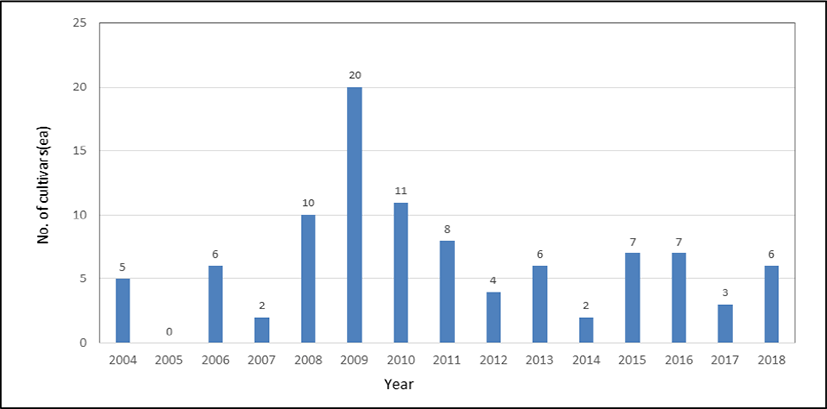
국제식물신품종보호제도가 시행되기 전 나라꽃 무궁화는 약 100여 품종이 국내 재배되고 있었다. 이들은 무궁화 실생묘를 그대로 심거나, 외국 품종을 도입하여 품종명만 개명하여 사용하였다(Kim, 1979; Kim, 2015). 따라서 새롭게 품종보호권을 획득한 품종들을 이용함으로써 품종보호 및 육종가의 권리를 행사할 수 있어야 할 것이다.
품종보호권을 획득한 품종들의 꽃의 종류는 대부분 홑꽃 품종이었으며, 반겹꽃 품종은 2품종, 겹꽃 품종은 전혀 없는 것으로 나타나 홑꽃 품종이 주를 이루고 있었다(Figure 2 참조). 꽃색의 경우, 꽃잎이 분홍으로 단심이 있는 품종이 57품종으로 가장 많았으며, 흰색 꽃잎에 단심이 있는 품종이 21품종으로 많았다. 그러나 꽃잎이 적색이고 단심이 있는 품종이 11개로 나타나, 기존의 무궁화 품종에 비해 꽃색이 다양화 되는 것을 알 수 있었다.
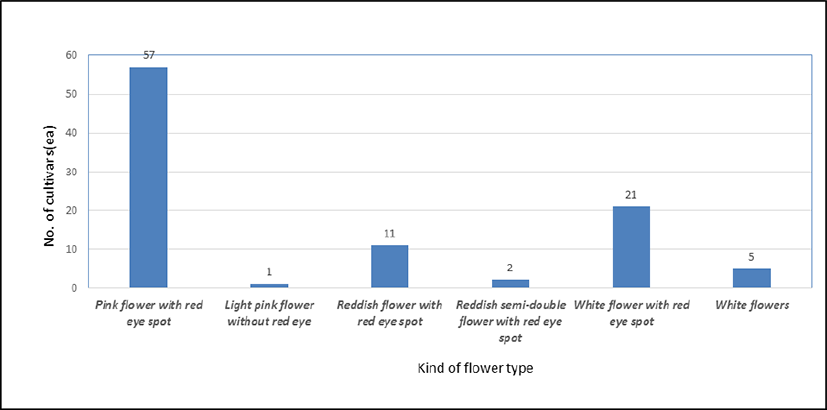
무궁화를 관상 가치가 높고 국민들의 사랑을 받을 수 있는 고급 화훼로 육성하기 위해 가장 중요한 점은 선명한 꽃색의 도입이라고 할 수 있다. 현재 보급 중인 무궁화는 백색에서 적자색에 이르기까지 다양한 꽃색 변이를 보이고 있으나, 다른 종의 꽃보다는 비교적 단조로운 꽃색 변이를 나타내므로 오래 전부터 여러 방면에서 꽃색 육종이 시도되어 왔다. 무궁화는 이들 무궁화속 식물 중 가장 내한성이 강한 종류로서, 앞으로 다른 무궁화속 식물과 교잡되어 종간잡종이 육성된다면 화려한 색상과 큰 화형을 가진 무궁화가 나올 수 있을 것이며, 이 경우 식물학적 근연관계를 따져 무궁화에 가까운 것은 무궁화로 불리게 된다(Yu and Yeam, 1987; CCRS, 1993).
국내 식물품종보호권을 획득한 품종은 무궁화 품종간 교잡육종법으로 개발된 품종이 61품종으로 가장 많았으며, 다음으로 종간 교배육종을 통해 육성된 품종이 23품종이었다(Figure 3 참조). 방사선 처리에 의한 돌연변이 육종은 7품종이었으며, 초기 무궁화 육종 방법으로 이용되던 실생묘 선발 육종 방법은 차츰 줄어들고 있는 것을 알 수 있었다.
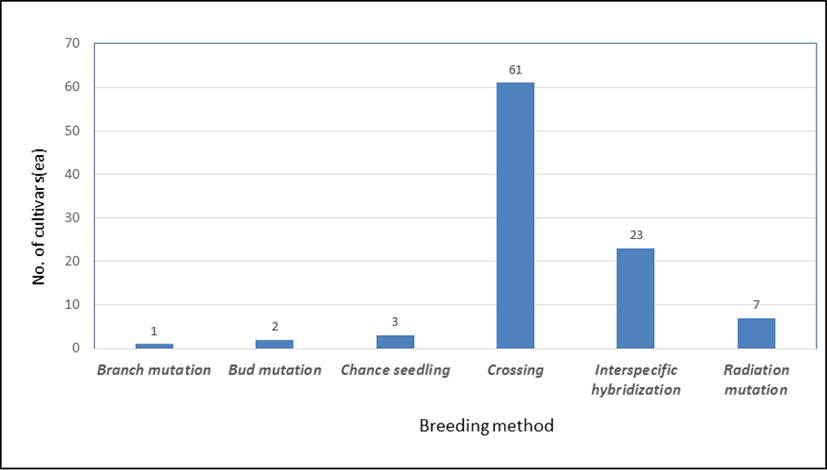
미국 특허청에 출원하여 특허를 받은 무궁화 신품종은 총 34품종이었으며, 캐나다에서 품종 보호권과 상표를 등록한 품종은 총 16 품종이었다(Table 5 참조). 미국에서 특허를 받은 신품종의 경우 캐나다에서도 품종 보호권과 상표 등록을 한 후 판매되고 있었다.
미국 및 캐나다에서 식물 특허 및 육종가 권리를 얻은 품종들의 선발 기준으로는 꽃이 특이한 품종이 가장 많았다. 꽃의 특성은 색, 크기, 형태(홑꽃과 겹꽃) 등이 가장 많았으며, 그 다음은 수형으로 가지의 배열이 조밀한 직립형과 키가 작은 왜성형이 많았다. 또한 ‘Aarticus’, ‘Carpa’, ‘Jodi’, ‘THEISSHSSTL’ 등은 잎 가장자리에 흰색 또는 노란색의 띠가 있는 품종이었다. 무궁화 신품종의 조경적 활용은 정원에 초점식재 및 분화 식재가 가장 많았으며, 울타리 및 가장자리 식재, 차폐식재가 있었다. 이들은 국내에서 개발된 품종에 비해 조경적 활용도가 높은 것으로 생각되었다. 등록한 품종의 경우, 18품종이 겹꽃, 4품종이 반겹꽃으로 미국에서는 반겹 또는 겹꽃 품종의 개발이 활발한 것으로 생각되었다.
미국과 캐나다에서 동시에 식물 특허 및 식물 육성자 권리를 받은 품종으로는 ‘America Irene Scott’, ‘Antong Two’, ‘CARPA’, ‘DVPazurri’, ‘Gandini Santiago’, ‘Gandini van Aart’, ‘ILVO347’, ‘ILVOPS’, ‘JWNWOOD 4’, ‘Notwood3’, ‘RWOODS5’, ‘SHIMCR1’, ‘SHIMRR38’, ‘SHIMRV24’, ‘THEISSHSSTL’ 등 15 품종이었다. 우리나라에서 육성하여 미국 및 캐나다에 특허 및 품종권리를 보호 받은 품종은 ‘Antong Two’ (Lil’ Kim®), ‘SHIMCR1’ (Lil’ Kim® Violet), ‘SHIMRR38’ (Ruffled Satin™), ‘SHIMRV24’ (Lil’ Kim® Red) 등이다. 우리나라에서 육성한 품종들의 경우, Lil’ Kim® 시리즈로 상표 등록되어 판매되고 있다. Lil’ Kim은 ‘Little Kim’의 줄임말로 키가 작은 왜성형이며, 한국의 대중적인 성인 Kim을 붙여 만든 것이다. ‘SHIM CR1’와 ‘SHIMRV 24’은 2010년 국내에서 품종보호권이 등록된 ‘종무’(품종보호권 3146호)와 ‘병화’(품종보호권 3147호)로 미국 및 캐나다로 수출되어 2013년 미국식물특허와 캐나다 육성자 권리보호를 받아 Ruffled SatinTM과 Lil’Kim® Violet으로 각각 상표 등록되어 온라인 및 오프라인 시장에서 판매되고 있다(Figure 4 참조).

미국 특허청(USPTO)에서 무궁화 품종 특허권을 처음 획득한 것은 2000년이었다(Figure 4 참조). 2000년 미국에서 식물특허를 받은 품종은 ‘Floru’, ‘Notwoodone’, ‘Mathilde’, ‘Marina’, ‘Notwoodtwo’ 등 4개였다. 이후 2007년까지 무궁화 특허가 없거나 1개 정도였으나, 2008년 영국에서 육성된 ‘Notwood3’, 벨기에에서 육성된 ‘DVPazurri’, 그리고 미국에서 육성된 ‘America Irene Scott’ 등 3 품종이 특허를 받았다. 이후 2012년부터 특허권 등록이 급격하게 증가하고 있다. 2016년에는 ‘ILVOPS’, ‘RWOODS5’, ‘MINDOUV5’, ‘MINDOUR1’, ‘Gandini van Aart’, ‘Aarticus’ 등 총 6품종이 특허권을 획득하여 가장 활발하였다. 미국 특허청에서 특허를 받은 6품종의 육성 국가는 벨기에, 영국, 프랑스, 네델란드, 미국 등이었으며, 유럽 국가들의 미국 특허를 신청으로 품종 특허가 점점 더 증가하고 있다(Figure 5 참조). 1930년 미국에서 식물 특허가 처음 등록된 이후 식물 신품종에 대한 지식재산권의 획득은 규모와 구매력 면에서 세계에서 가장 큰 시장에 진입할 수 있는 산업적 가치와 식물 생명공학 기술의 글로벌 리더로서 세계적으로 인정받는 기술적 가치를 갖는 것으로 볼 수 있다. 미국의 경우, 무성번식 식물이 대상인 식물 특허에 더 많은 품종들이 출원되고 있고, 유럽연합 27개 회원국 연합체인 CPVO의 출원 건수에 이어 세계 2위 수준으로 단일 국가로는 가장 많다.
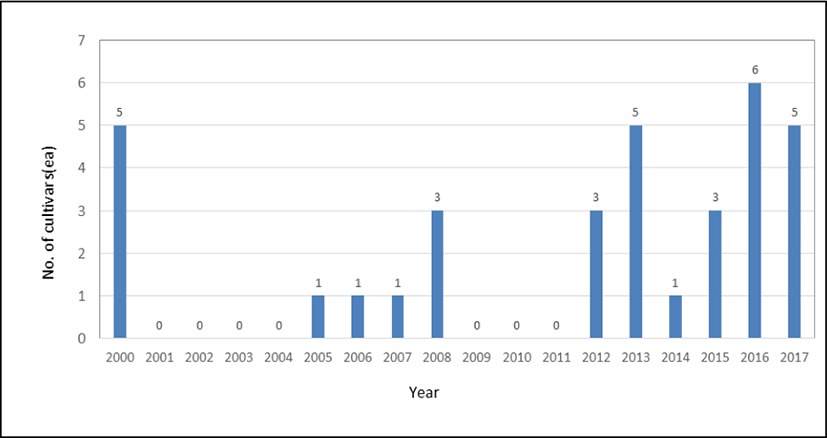
미국에서 식물 특허는 1930년 처음 등록되었으며, 식물 특허의 등록번호는 가령 PP14,171과 같이 “PP”로 시작되며, 특성 상 등록 특허의 수가 많지 않아서, 2011년 6월 23일 현재 21,988 식물체에 대한 특허가 등록되어 있다(Lee, 2012).
2000년부터 2018년까지 미국 특허청(USPTO)과 캐나다 식품검사기관(CFIA)에 등록된 무궁화 품종의 육성 국가별 분포를 보면 미국, 영국, 네델란드, 한국, 프랑스, 캐나다, 벨기에 등이 있었다(Figure 6 참조). 미국 특허청의 경우, 미국, 영국, 네델란드에서 육성된 품종이 각각 7개로 가장 많았으며, 그 다음은 한국 4개 품종, 벨기에 3개 품종이 등록되었다. 미국에서 육성하여 미국 특허를 획득한 품종으로는 ‘THEISSHSSTL’(Sugar Tip® Gold), ‘DS01BS’(Blueberry Smoothie™), ‘America Irene Scott’(Sugar Tip®), ‘Aarticus’(Summer Ruffle™), ‘DS04PS’ (Peppermint Smoothie™), ‘Jodi’, ‘DS03RS’(Raspberry Smoothie™) 등이 있으며, 이들은 Sugar Tip® 상표 등록되어 Smoothie™ 시리즈로 판매되고 있다. 영국에서 육성하여 미국 특허를 받은 품종으로는 ‘JWNWOOD 4’(Pink Chiffon®), ‘Notwood3’(Blue Chiffon®), ‘RWOODS6’(Starburst Chiffon®), ‘Notwoodone’(Lavender Chiffon®), ‘RWOODS5’(Magenta Chiffon®), ‘Notwoodtwo’(White Chiffon®), ‘WALHIROSMO’(Walberton®) 등이며 이 품종들은 Chiffon® 시리즈로 상표 등록되어 판매되고 있다. 네델란드에서 육성하여 미국 특허를 받은 품종으로는 ‘Gandini Santiago ’(Purple Pillar®), ‘Summer Festival’(Summer Festival®), ‘Marina’ (Blue Satin®), ‘Summer Holiday’(Summer Holiday®), ‘Gandini van Aart’(White Pillar®), ‘Mathilde’(Blush Satin®), ‘Summer Night’(Summer Night®) 등이 있다.
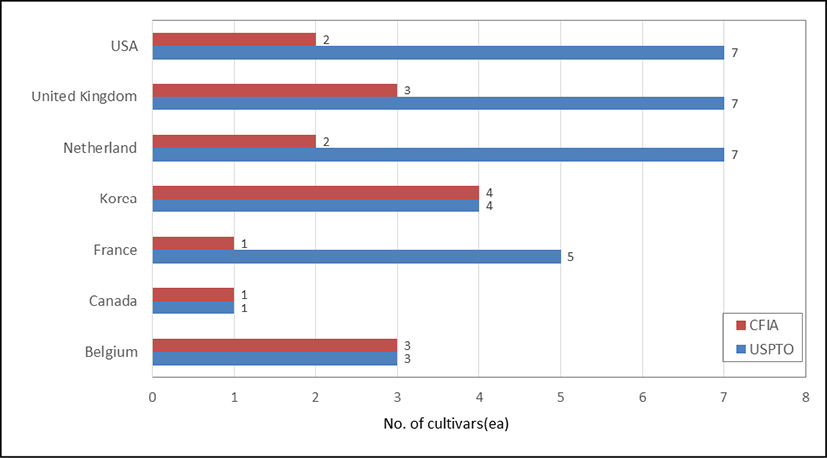
다음으로 프랑스에서 육성하여 미국 특허를 받은 품종으로는 ‘MINDOUV5’(French Cabaret® Purple), ‘MINDOUB1’(French Cabaret® Pastel), ‘MINDOUR1’(French Cabaret® Red), ‘Bricutts’ (China Ciffon®), ‘Floru’(Violet Satin®) 등이 있다. 또한 벨기에에서 육성하여 미국 및 캐나다에 특허 및 품종권리를 획득한 품종으로는 ‘ILVOPS’(Purple Satin®), ‘ILVO347’(Orchid Satin®), ‘DVPazurri’(Azurri Blue Satin®) 등이 있으며, 각각 Satin® 시리즈로 상표 등록되어 판매되고 있다. 캐나다(CFIA)에 등록한 품종의 경우, 우리나라에서 육성한 품종이 4개로 가장 많았으며, 다음은 벨기에와 영국에서 육성한 품종이 3개로 많았다. 반면, 미국에서 육성한 품종은 2개였고, 캐나다는 무궁화 신품종을 1개 등록하였다.
미국 특허권을 획득한 무궁화의 육종 방법에 의한 품종 수는 품종간 교배육종이 총 17건으로 가장 많았으며, 다음으로는 줄기의 돌연변이 개체를 선발하여 육성한 품종이 총 8개, 자연방임 수분된 실생묘 중 형태적 특성이 우수한 개체를 육성한 품종이 6개였다(Figure 7 참조). 그 외 우연실생묘 중 특성이 우수하여 선발된 품종과 종간교잡 육종, 돌연변이 육종으로 육성된 품종들이 각각 1개씩 있었다. 이들은 우리나라에서 무궁화 품종을 육성하는 방법과는 차이가 있는 것을 보여준다. Dirr (2009)은 무궁화는 다양한 꽃의 형태적 특성이 후대에 뚜렷하게 나타나기 때문에 육종가들에게는 금광과도 같다고 하였다. 따라서 조경적 이용에 있어 무궁화의 다양한 꽃색 및 꽃이 특이한 품종을 개발하기 위해 무궁화속(Hibiscus spp.)의 다양한 유전자원을 활용해야 할 것으로 생각된다.
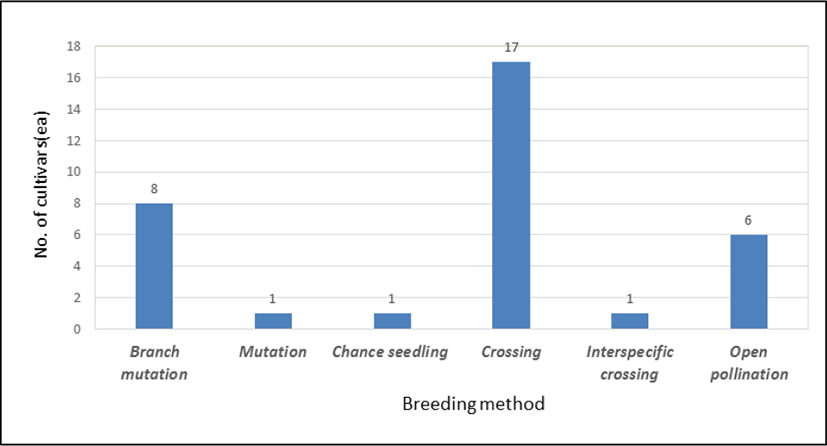
2003년부터 2018년까지 유럽공동체 식물품종사무국(CPVO) 에서 무궁화 신품종 보호권을 획득한 품종은 총 32개였다(Table 6 참조). 이중 육종 방법은 대부분 품종 간 교배육종이 주를 이루고 가지 돌연변이 및 우연 실생묘에서도 품종을 선발한 것으로 나타났다. 또한 노산부용(H. paramutabilis)과 무궁화(H. syriacus) 의 종간교잡종으로 무궁화의 특성이 강한 품종인 ‘Resi’와 ‘WALHIROSMO’이 2008년과 2015년에 각각 발표되었다. 유럽에서 신품종보호권을 받은 품종들의 선발 기준은 꽃의 색, 크기, 형태(홑꽃과 겹꽃) 등이 가장 많았으며, 다음은 수형으로 가지의 배열이 조밀한 직립형이 많았다.
무궁화 종간교잡종인 H. paramutabilis × syriacus ‘Resi’는 수세가 강하고 키가 큰 교목성이며, 가로수 및 초점식재용으로 활용되고 있다. ‘Gandini Santiago’와 ‘Gandini van Aart’은 가지의 배열이 조밀하고 위로 자라는 직립형으로 가로수 및 독립수로 활용도가 높아 유럽 시장에서 판매가 활발할 것으로 생각된다. 또한 내한성이 강해 선발된 ‘Éléonore’는 –15℃에서도 월동이 가능하여 유럽에서 인기가 높을 것으로 생각되었다. 유럽에서 신품종 보호권을 등록한 품종들의 조경적 활용은 독립수 식재가 가장 많았으며, 다음으로 화단 및 울타리 식재가 있고, 가장자리 식재도 있었다. 또한 유럽 품종보호권을 획득한 무궁화 품종의 꽃 종류는 겹꽃 품종이 11개(34.3%), 반겹꽃이 7개(21.9%), 홑꽃 품종이 14개(43.8%)였다. 유럽의 경우, 겹꽃과 반겹꽃 품종이 55%이상인 것으로 나타나, 대체로 겹꽃을 선호하는 것으로 생각되었다(Table 6 참조).
1960년대 식물 육종에 민간 분야의 참여가 확대됨에 따라 여러 유럽 국가들은 식물신품종보호법을 도입하였으나, 당시에는 육종가 권리 부여 기준이 국가마다 상이하였고, 품종에 대한 개념도 일관되게 정의되어 있지 않은 상태였다. 뿐만 아니라 육종가 권리를 자국민에게는 부여하였지만, 외국인에게는 부여하지 않았다. 식물 육종가 권리는 1961년 ‘식물신품종보호에 관한 국제협약(UPOV 협약)’이 채택되면서 국제적으로 인식되기 시작하였고, 이 협약을 통해 회원국들의 식물신품종보호법을 조화시키고자 하였다(UPOV, 2005).
유럽연합은 우리보다 2년 앞선 1995년에 품종보호제도를 도입하였으며, 이 제도는 한 번의 출원으로 전체 회원국(28개국)에서 품종보호를 받을 수 있는 장점을 갖고 있다(Park et al., 2016). 2013년도 유럽연합 품종보호 출원 건수는 2012년도 2,868건에 비해 15% 증가한 3,297건으로 제도 도입 후 최대 출원 건수를 기록하였다(CPVO, 2014). 관상 식물류는 매년 유럽연합 품종보호출원의 가장 큰 부분을 차지하고 있고, 2013년에는 전체 출원의 50%를 차지하고 있다. 아울러 관상작물 육종은 주로 중소업체에서 이루어지며, 품종 출원의 특징은 종(種)은 다양한데 비해 종별 출원 건수는 비교적 적다는 것이다 (Park, et al., 2016). 따라서 무궁화의 유럽 수출 기회는 확대될 것으로 생각된다.
유럽의 식물신품종 보호권 획득은 2012년, 2016년 및 2017년에 각각 4품종으로 가장 많았다(Figure 8 참조). 반면, 2011년까지는 무궁화 신품종의 출원 신청이 적었으나, 2012년부터 증가하는 추세를 보였다. 이는 Figure 5에서 나타난 바와 같이 미국과 캐나다의 무궁화 출원 증가와 유럽 내 신품종 보호권 출원이 동시에 증가한 것을 보여준다.
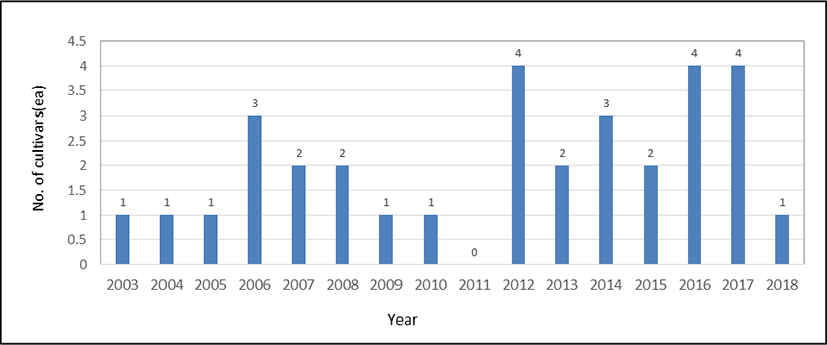
2003년부터 2018년까지 유럽공동체 식물품종사무국(CPVO) 에 등록된 무궁화 품종의 육성 국가는 프랑스, 네델란드, 영국, 미국, 벨기에였다(Figure 9 참조). 프랑스가 16개 품종으로 가장 많았으며, 다음은 네델란드 9개 품종, 영국 5개 품종, 벨기에 1개 품종을 등록하였다.
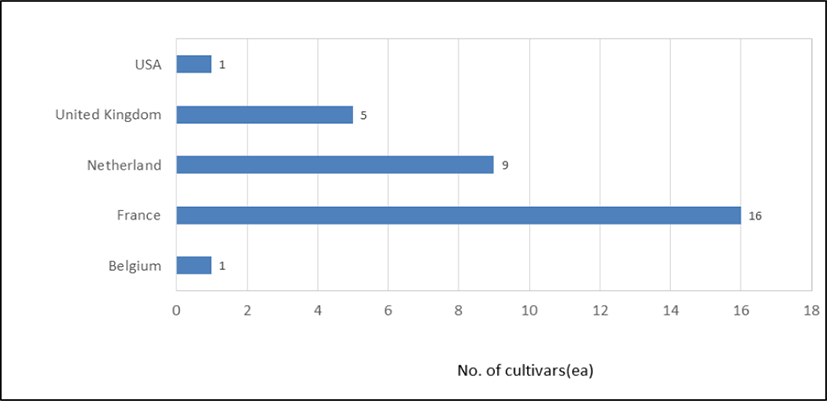
프랑스에서 육성된 무궁화 품종은 ‘MINSYBLE9’(Ultramarine®), ‘MINSYGRBL1’(Hawaii™), ‘Éléonore’, ‘Britreize’(Kimono™), ‘Minultra’(Ultramarine®), ‘Mineru’(Tahiti™), ‘Bricutts’(China Chiffon®), ‘Minspot’(Pinky Spot®, Fiji™), ‘Minfren’(Bali™), ‘Minomb’(SUP’Heart®), ‘MINDOUB1’(French Cabaret® Pastel), ‘Minpast’(Pastel Rose™), ‘MINSYRU3’(Russian Violet®), ‘MINDOUR1’(French Cabaret® Red), ‘MINSYROI5’(SUP’Blue®), ‘MINDOUV5’(French Cabaret® Purple) 등이었으며, 이들은 다양한 상표명으로 등록되어 유럽 각지에 판매되고 있다. 프랑스에서 육성된 품종들의 상표명은 Hawaii™, Tahiti™, China Chiffon®, Fiji™, Bali™, French Cabaret® 등으로 국가명을 상표로 만들며, 세계화에 적극적인 것을 알 수 있었다. 또한 ‘Britreize’ 은 상표를 Kimono™로 정해 일본적인 특성을 나타냈다. 또한 종간교잡육종으로 육성된 ‘Resi’는 키가 14∼16m까지 자라는 교목성이며, ‘WALHIROSMO’ 역시 꽃의 크기가 기존 품종에 비해 큰 특성이 있어 유망한 품종으로 생각된다. 이와 같이 유럽공동체에서는 프랑스에서 무궁화의 육성 및 판매가 활발한 것으로 보인다. 유럽 품종보호권은 미국이 1개 품종만 등록하였고, 유럽 국가들의 신청이 대부분을 차지하였다. 미국 특허의 경우, 유럽 및 미국, 캐나다, 한국 등 다양한 국가에서 무궁화 신품종 특허를 신청하는 것으로 나타났으며, 무궁화 신품종의 수출을 위해서는 앞으로 미국 및 유럽 공동체에 신품종 특허 신청을 확대시켜야 할 것으로 생각된다.
Table 4, 5, 6에서 나타난 국내외 무궁화 신품종 선발 기준을 조사한 결과, 국내에서는 무궁화 신품종 육종의 기준은 꽃이 가장 많았으며, 다음으로 수형이 특이한 것으로 국한되어 있었다. 반면, 미국 및 캐나다에서 식물 특허를 얻은 품종들의 선발 기준으로는 꽃, 수형, 잎, 불임성 등 다양하였으며, 유럽 역시 육종 기준이 꽃, 수형, 내한성 등 다양하였다(Figure 10 참조).
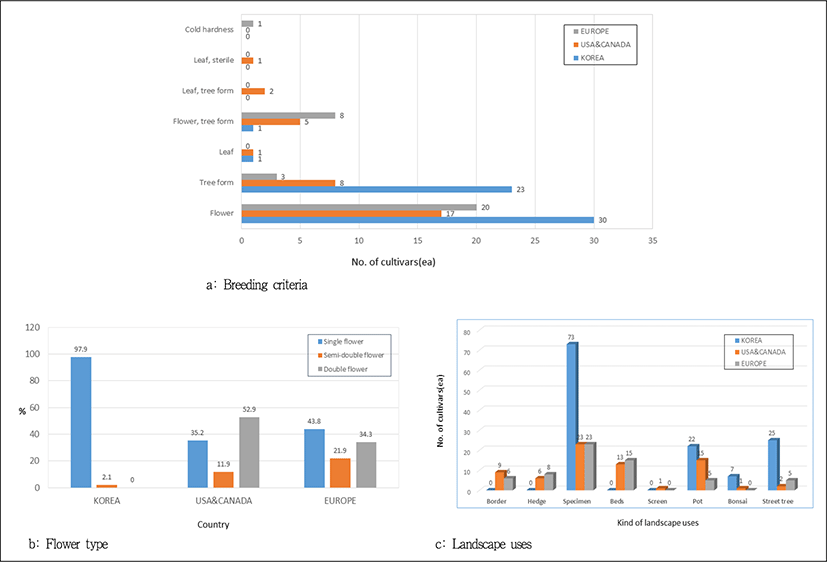
국내에서 품종보호권을 획득한 품종들의 꽃의 종류는 97.9%가 홑꽃 품종이었으며, 반 겹꽃 품종은 2.1%, 겹꽃 품종은 전혀 없었다. 반면, 미국 및 캐나다에서 특허 등록된 품종의 경우, 52.9%가 겹꽃, 11.9%가 반겹꽃이었으며, 유럽 품종보호권을 획득한 무궁화 품종은 겹꽃 품종이 34.3%, 반겹꽃이 21.9%, 홑꽃 품종이 43.8%로 꽃잎이 많은 겹꽃 계통을 선호하는 것으로 생각되었다. 따라서 나라꽃 무궁화의 해외 수출을 위해서는 다양한 겹꽃과 반 겹꽃 품종을 개발해야 할 것이다.
국내에서 육성된 품종의 조경적 이용은 분화용, 분재용, 독립수, 가로수용으로 매우 제한적인 것을 알 수 있었다(Figure 10 참조). 이중 독립수가 48 품종으로 가장 많았으며, 다음으로 독립수 및 가로수용이 많았다. 국내에서 육성된 신품종은 가로수용이 25품종으로 많은데 반해, 미국에서는 2품종, 유럽에서는 5품종으로 적은 것을 알 수 있었다. 미국 및 유럽에서는 무궁화의 조경적 활용이 가로수용보다는 분화 및 화단 지피식재용, 또는 가장자리 식재용으로 다양한 것을 알 수 있었다. 반면, 미국에서 식물특허를 받은 무궁화 품종은 가장자리 식재 및 울타리용, 분화용, 분재용, 화단 지피용, 차폐식재용, 독립수용, 가로수용으로 이용하고 있었다. 이중 독립수 또는 화단용으로 이용할 수 있는 품종이 36개로 가장 많았으며, 분화용으로 이용할 수 있는 품종이 총 15 품종으로 유럽에 비해 많았다. 유럽에서 품종 등록된 무궁화 품종의 조경적 활용은 가장자리 식재용, 화단 지피용, 분화용, 울타리 식재, 독립수, 가로수 식재 등으로 분류되었다. 유럽 품종은 초점식재 또는 화단용 식재가 38품종으로 가장 많았으며, 독립수 및 울타리용 품종이 다음으로 많아 미국 품종과 비슷한 경향을 보였다. 따라서 미국 및 유럽 품종의 경우, 독립수, 울타리용, 가장자리 식재용, 화단 지피용 등 다양한 용도로 활용이 넓은 것을 알 수 있었다(Dirr, 2009). 향후 나라꽃 무궁화의 품종은 국내 보급 확대 및 해외 수출을 위해서는 꽃의 종류가 홑꽃에서 겹꽃 품종의 개발이 요구되어지며, 꽃색 또한 적색, 청색 등 다양해야 할 것이다. 또한 무궁화 품종의 신품종 개발 시 미국 및 유럽품종처럼 화단 지피용 및 가장자리 식재용으로 이용하기 위해 키가 작고 가지가 아래로 향하는 품종 개발이 요구되어야 할 것이다. 또한 키가 작고 마디의 길이가 짧으며 분지각도가 좁은 품종을 개발하여 분화용 및 분재용으로 개발하여 실내에서도 무궁화를 감상할 수 있도록 해야 할 것이다. 그러나 개화기 때 부족한 광과 환기를 위해 창가 베란다에서 재배하는 것이 요구되며, 이에 대한 생리, 재배적인 연구가 향후 진행되어야 할 것이다. 지금까지 국내에서 육성된 품종이 미국 및 캐나다에서만 특허가 등록되었으나, 향후 유럽시장까지 확대할 수 있는 품종이 개발되어야 할 것이다.
IV. 결론
본 연구는 국제 식물 신품종 보호제도가 실시된 이후 무궁화 (H. syriacus)와 종간교잡종(Hibiscus hybrids)으로서 국내 및 미국, 캐나다, 유럽 등에서 식물 특허 및 품종보호권을 획득한 무궁화 품종에 대하여 개발 국가, 육종 방법, 품종 특성, 선발 기준, 조경적 활용 등을 밝히고자 하였다. 향후 나라꽃 무궁화를 국내에 확대 보급할 뿐 아니라, 해외 수출을 촉진시키고, 용도를 확장시키기 위한 기초 자료로 활용하고자 하였다.
국내에서 개발된 무궁화 품종 중 2004년부터 2018년까지 국립종자원에서 품종보호권 번호를 획득한 품종은 총 97개였다. 국내 육성 품종의 선발 기준은 특이한 꽃이나 수형이 대부분이었으며, 잎이 특이한 것도 있었다. 꽃의 크기, 모양, 단심이 특이한 품종들은 정원 내 초점식재용으로 활용이 가능하다. 수세가 강하고 키가 큰 교목성 품종들은 가로수 및 초점식재용으로, 가지의 배열이 조밀하고 키가 작은 왜성형은 분화 및 분재용으로 이용할 수 있다. 식물신품종보호제도 이후 2009년에 무궁화 품종보호권이 20개로 가장 많이 등록되었으며, 이후 감소하는 경향을 보였다. 품종보호권을 획득한 품종들은 대부분 홑꽃 품종이었으며, 반겹꽃 품종은 2품종, 겹꽃 품종은 전혀 없었다. 꽃색의 경우, 꽃잎이 분홍으로 단심이 있는 품종이 57개로 가장 많았으며, 흰색 꽃잎에 단심이 있는 품종이 21개로 많았다. 그러나 꽃잎이 적색이고 단심이 있는 품종이 11개로 나타나 기존의 무궁화 품종에 비해 꽃색이 다양화 되는 것을 알 수 있었다. 품종보호권을 등록한 품종의 육종 방법은 무궁화 품종 간 교잡육종법으로 개발된 품종이 61개로 가장 많았으며, 다음으로 종간 교배육종을 통해 육성된 품종이 23개, 방사선 처리에 의한 돌연변이 육종이 7개 있었다. 국외에서 개발된 무궁화 신품종을 조사한 결과, 미국 특허청(USPTO)에 출원한 무궁화 품종은 미국, 영국, 네델란드에서 각각 7개 품종으로 가장 많았으며, 다음은 한국에서 4개 품종, 벨기에가 3개 품종을 등록하여 총 34품종이었다. 유럽공동체 식물품종사무국(CPVO)에 등록한 무궁화 품종은 프랑스에서 육성한 품종이 16개로 가장 많았으며, 다음은 네델란드에서 9개 품종, 영국에서 5개 품종, 벨기에가 1개 품종으로 나타나 총 32품종이었다. 미국과 캐나다에서 동시에 식물 특허 및 식물 육성자 권리를 받은 품종으로는 ‘America Irene Scott’, ‘Antong Two’, ‘CARPA’, ‘DVPazurri’, ‘Gandini Santiago’, ‘Gandini van Aart’, ‘ILVO347’, ‘ILVOPS’, ‘JWNWOOD 4’, ‘Notwood3’, ‘RWOODS5’, ‘SHIMCR1’, ‘SHIMRR38’, ‘SHIMRV24’, ‘THEISSHSSTL’ 등 15품종이었다. 국내 품종보호권과 해외 식물 특허를 동시에 취득한 품종으로 ‘SHIMCR1’ 과 ‘SHIMRV24’이 있었다. 미국 식물 특허와 유럽 신품종보호권을 동시에 받은 무궁화 품종은 총 14품종으로 ‘America Irene Scott’, ‘Bricutts’, ‘DVPAZURRI’, ‘Gandini Santiago’, ‘Gandini van Aart’, ‘JWNWOOD4’, ‘MINDOUB1’, ‘MINDOUR1’, ‘MINDOUV5’, ‘NOTWOOD3’, ‘RWOODS5’, ‘RWOODS6’, ‘Summer Holiday’, ‘Summer Night’ 등이었다. 미국 식물 특허권을 획득한 무궁화 품종중 겹꽃 품종이 18개(52.9%), 반겹꽃이 4개(11.8%), 홑꽃 품종이 12개(35.3%)로 나타나 겹꽃 품종이 많았으며, 유럽 품종보호권을 획득한 무궁화 품종에서도 겹꽃 품종이 11개 (34.3%), 반겹꽃이 7개(21.9%), 홑꽃 품종이 14개(43.8%)로 나타나 미국과 같은 결과를 보였다. 또한 미국 및 유럽에서 개발된 무궁화 품종의 꽃색 또한 국내 품종에 비해 다양한 것으로 나타났다. 국내 품종보호권을 등록한 품종의 경우 대부분 홑꽃 품종으로 꽃색 또한 자단심계, 백단심계, 적단심계, 배달계 등으로 제한적이었다. 향후 나라꽃 무궁화의 품종은 국내 보급 확대 및 해외 수출을 위해서는 꽃의 종류가 홑꽃에서 겹꽃 품종의 개발이 요구되어 지며 꽃색 또한 적색, 청색 등 다양해야 할 것이다. 또한 무궁화 품종의 신품종 개발 시 미국 및 유럽품종처럼 화단 지피용 및 가장 자리식재용으로 이용하기 위해 키가 작고 가지가 아래로 향하는 품종 개발이 요구되어야 할 것이다. 또한 키가 작고 마디의 길이가 짧으며 분지각도가 좁은 품종을 개발하여 분화용 및 분재용으로 개발하여 실내에서도 무궁화를 감상할 수 있도록 해야 할 것이다.
